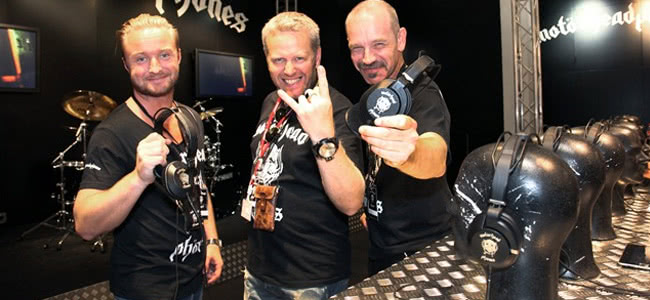The International Consumer Electronics Show (CES) sees companies and technology developers the world over showing off their latest electronic innovations, goofy gadgets, and fancy designs for the future. Held annually, the 2013 edition of CES provided three days of madness in Las Vegas before drawing to a close last Friday, but there was a number of interesting announcements for music fans at the event.
Most interestingly was Motörhead frontman Lemmy Kilmister unveiling the cheekily titled Motörheadphones, the uniquely branded line is set to be the ‘anti-Beats’ of the industry, designed especially for rock fans and musicians according to Rolling Stone.
Unlike Dr. Dre’s Beats brand, which emphasises the low-end frequencies for rap and hip-hop, the Motörheadphones bring out the all-important midrange of metal and heavy rock.
“People say we’ve never sold out,” Lemmy joked at the launch for his new branded cans, “[but] no one ever approached us.” Brand Manager Andres Nicklassen and CEO Ulf Sandberg did just that, roping in the Motörhead icon and his branding after complaining that most popular headphones use too much bass, draining ‘the soul’ out of rock. Or, as Kilmister puts it: “It’s like you’re listening through a towel.”
The Motörheadphones range will be made available in the US from April in a range of in-ear and over-ear designs, with price starting at $US 49.99 right through to $129.99.
Never to be outdone in the heavy rock merchandise stakes, AC/DC are lending their endorsement to On.Earz to make a set of branded headphones, which -as music blogger Alan Cross points out, is more to do with licensing their image than getting any further development of the Aussie rock legends.
If you happen to do most of your music listening underwater however, then Sony’s CES debut of their new waterproof digital Walkman is likely to get you excited. As Mashable reports, the tech giant revealed that their new NZW-W270 model, which contains a 4GB digital music player built into a pair of earphones, is aimed at swimmers (or particularly sweaty athletes) looking for a soundtrack to their workout.“People say we’ve never sold out… [but] no one ever approached us.” – Lemmy, Motörhead
Available at $US 99.99 bucks a pop, the waterproof headphones are available in black, white, blue, and pink from March, and uses its own specialised dongle to connect to computers to transfer music.
CES 2013 also proved that music streaming services, like Pandora, Spotify, and Deezer may well be making the leap off of computers and smartphones and towards some other common electronic dwellings, namely, your kitchen.
Refrigerator manufacturer Whirlpool is banking that their new CoolVox range will have chefs singing and dancing as they open the door to their culinary selections, a speaker inside will stream music from a smartphone or compatible Bluetooth device, as Alan Cross reports.
Whirlpool reason that it’s a good alternative for people with limited counter space, or simply don’t want their kitchen cluttered up with sound docks and players.
The last noteworthy item to emerge from CES is an interactive tech toy called the gTar, which TechCrunch details is an electric guitar that uses an embedded iPhone to load songs from its music library, and then uses LEDs along the fretboard that light up beneath the strings to ‘teach’ the user how to play a song through finger placement, with the additional function of recording performances.
A product from Incident, the gTar is the result of three years of design stages and protoypes, helped in large part by raising more than $US 350,000 and 1,000 orders through a Kickstarter campaign.
Co-founder Idan Beck says they were only expecting a few hundred orders or so from early adopters, but soon found themselves ratcheting up the manufacturing process to meet an intense demand for the new interactive guitar.
“We got a lot of really, really mainstream backers” says Beck, “and the response they had was that they expected it to be commercial grade — something that you could put on the shelf and buy it ready-to-go.” Incident then refined the gTar, including firmware updates in cartridges that pop in and out of the device, as well increasing software developer access so that others can design apps built specifically for the gTar.

































